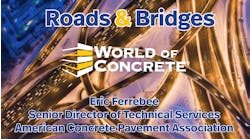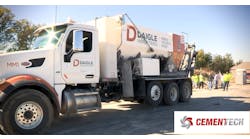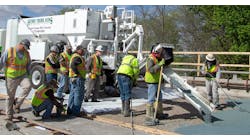By: Ed Bartels, P.E., PLS
Johnson County comprises some 620 square miles of pastoral eastern Iowa farmland nestled against both sides of the Iowa River.
Interstate 80 bisects the county from west to east on its way from Omaha to Chicago. Interstate 380/U.S. 218, a major link in the nearly completed “Avenue of the Saints,” winds north-south through the middle of the county linking us to neighboring Cedar Rapids and more distant St. Paul and St. Louis.
Sprinkled amid Grant Wood’s famous rolling hills are the urban development areas. Anchored by Iowa City and the University of Iowa campus, bedroom communities have sprung up or simply taken over some of the nearby rural farm communities, many of which have now grown into urban areas in their own right.
The population has grown steadily, if a bit more slowly at around 4%, through the recent recession to its current total of 136,000. Our residents earn slightly more than the average salary in Iowa, with significantly above average home values. They are engaged and active in local government and more than 50% of them hold a bachelor’s degree or higher. To say there are high expectations of service would be an understatement.
The county’s geographic location at a nexus of transportation arteries and its rapidly growing population result in a need for increased capacity on our rural major collectors. The network must support modern farm commerce with its increasingly oversize implements and safely accommodate heavy truck and commuter traffic simultaneously. Further, there is a large community of bicyclists whose needs must be considered as well.
Competing needs are nothing new, nor is the somewhat deplorable state of our infrastructure, be it at the national, state or county level. Where once the U.S. ranked as undisputed No. 1 in the world, many industrialized nations can now be said to have caught up or even surpassed us in terms of infrastructure quality, depending upon which study is chosen for comparison. For many years, our infrastructure has served so well that it has been largely ignored. Unfortunately, that neglect has a significant cost, and the bill is now due.
Economy in designs
The Secondary Roads Department at Johnson County is responsible for more than 900 miles of roadway. We have 150 paved miles, with the balance made up of rock and dirt. Traffic level varies from 50 AADT on our local access roads to more than 7,000 on major collectors. Costs to rehabilitate our paved roads also vary widely, from $500,000 per mile for a typical 28-ft-wide pavement overlay/widening project to more than $1.5 million per mile for a full reconstruction, 34-ft-wide pavement with ROW acquisition and major alignment or profile changes. We devote roughly a third of our $3.4 million construction funding to bridges and other structure work each year, so we’ve got about $2 million per year left for roads.
At this level of funding, we can rehabilitate and upgrade an average of 3 miles per year but it will take us 50 years or more to get them all completed. Unfortunately, it’s not very likely we’ll get 50 years out of our pavements and we cannot simply ignore the other 750 miles we’re responsible for. This situation, one shared by virtually every public works agency in the country, is completely untenable. As part of our annual five-year road program preparation in 2010, we presented that information to our board of supervisors. To their great credit, they not only understood the problem, but they have since taken definitive action to help increase infrastructure funding.
Thanks in part to some work by the Iowa legislature, the board was able to provide us with additional funding that has almost doubled our annual construction budget via local bonding for specific projects. While this will provide benefits well in excess of the bond cost in terms of both economic development and increased level of service for our system users, bonding is an additional burden for our taxpayers, and we cannot count on it being there each year. However, while the funding is available we have a unique opportunity to not only keep up with our system needs, but if we can find enough economy in our designs, we may even have a chance to improve it. This is the challenge for our department going forward.
Debunking D-cracking
Our first foray into PCC overlays began shortly after the big run-up in oil prices in 2008. The jump in crude led to a staggering increase in performance-graded binder costs, which exploded one of our hot-mix asphalt (HMA) rehabilitation project budgets. PCC overlays appeared to offer a number of benefits in terms of economy, sustainability and cost volatility, so we decided to evaluate PCC overlay on our next rehab project.
In 2009, we prepared an overlay design for a portion of Highway 965, an old state road handed down and rather reluctantly accepted by the county due to its condition. This road carries more than 3,700 vehicles per day with an estimated 3% trucks. The existing pavement is 24 ft wide and was constructed as a nominal 91?2-in. PCC pavement with a 10-in. thickened edge in 1957. It was overlayed with a nominal 2 in. of HMA at some point in the 1980s. In addition to faulting, tenting, and plenty of fatigue cracking, this pavement exhibited symptoms of D-cracking. Pavement cores and aggregate source records later confirmed this diagnosis. In an attempt to control the D-cracking in the existing pavement, we installed subdrain on each side. While the best practice for eliminating D-cracking remains completely recycling the pavement, it is our hypothesis that limiting the moisture available to cause D-cracking damage will minimize its effect on the service life of the new overlay.
The new pavement design is a nominal 8-in. unbonded PCC overlay set on a 1-in. HMA stress-relief, or bond-breaker course; with a 5-ft-wide, 8-in. PCC widening unit and 2-ft-wide aggregate shoulder set on 4 in. of modified sub-base on each side connected to the subdrain system.
We milled off the old HMA overlay prior to placement of the new bond-breaker, due to concerns of “keying” the new unbonded overlay into the old pavement if we were to keep it in place. We included dowels on the transverse mainline joints at 15-ft spacing to limit faulting. The new pavement was constructed half-width, under traffic, using one-way traffic control, a novel approach for rural high-speed arterials that was used on a sister project designed by Anderson-Bogert Engineering of Cedar Rapids. This allowed us to provide hard-surface access to our residents throughout construction and allowed continuous if somewhat inconvenient access to several businesses as well.
The paving contractor for this project was Streb Construction Co. Inc. of Iowa City. They used an Iowa DOT-approved C-3WR-C20 concrete mix, which contained: Type I/II portland cement with 20% Class C fly ash substitution; a 55/45 coarse/fine aggregate ratio; and retarding, water-reducing and air-entraining admixtures. Air content target was 8% in front of the paver with a target of 6% in the finished slab. No batch plant was available, so the contractor used a combination of dump trucks and ready-mix trucks to deliver material to the site. We have excellent quality crushed limestone available in Johnson County, so we were able to secure the highest durability (Type 3i) aggregate, which is usually only specified on the interstate system in Iowa, at no additional cost. Time to open pavement to traffic was determined using the maturity method and generally did not exceed 30 hours to a minimum 500-psi flexural strength.
After four years in service, this pavement is performing flawlessly, with no visible damage whatsoever. The design life of this pavement is a conservative 20 years due to the unknown performance of the sub-pavement, but if the subdrain system mitigates any further D-cracking damage as expected, the service life will likely exceed 40 years. Total project cost was $2.2 million for 2.8 miles—an average cost of about $785,000 per mile—which reflects the additional premium cost of construction under traffic and phasing.
Lessons and time-tested
We completed our most recent PCC overlay in 2012 using many of the lessons we learned on Highway 965. The 2012 project consisted of a 1-mile portion of 520th Street about 3 miles east of the city of Hills. This segment carries more than 2,200 vehicles per day with estimated 5% trucks. The existing pavement is a 22-ft-wide, full-depth HMA. The pavement exhibited a number of distress types including some limited alligator cracking and pronounced deterioration at the transverse joints. However, there was no indication of significant subgrade failure, and no D-cracking, making it an ideal PCC overlay candidate.
For this project, we chose a time-tested Iowa design—a nominal 6-in. unbonded PCC overlay, 22 ft wide with no bond breaker. We were able to use a thinner section due to the more certain sub-pavement condition. We added a 5-ft-wide, 8-in. PCC widening unit and 2-ft-wide aggregate shoulder supported by 6 in. of modified sub-base on each side of the existing pavement. In lieu of a subdrain system, we elected to “daylight” the modified sub-base directly to the foreslope. We hope this will prove to be an even more effective continuous drainage path that does not require maintenance and costs significantly less than the subdrain it replaces. Because the overlay thickness is only 6 in., dowel bars for load transfer were not recommended and not included. Transverse joint spacing was set at 12 ft.
The paving contractor for this project was Croell and Subsidiary (CFI) of New Hampton. They used an almost identical C-3WR-C20 concrete mix design for this segment, again with 8% target air content. Due to the proximity of a suitable detour route and a complete lack of residences on the segment, we chose to completely close the road to traffic during construction. We estimate this saves at least 25-30% on construction time when compared to half-width under traffic, or phased construction.
The contractor paved the entire 32 ft width of the mainline project length over the course of about four full days. No batch plant was available, so ready-mix trucks were used to supply material to the site. We again specified the maturity method to determine the time of opening to traffic. This allows not just residents, but the contractor to access the new pavement earlier, saving time and money, which saves us as well.
Though this pavement has only been in service for six months, there is no apparent damage to the pavement due to cyclical winter frost action. Total project cost was $915,000 for 1.1 miles, which includes the overlay of two intersections, approximately $200,000 in box culvert replacements, and added costs for earthwork related to the pavement widening. If that’s taken into account, our overlay cost per mile on this segment is less than $650,000.
Overlay optimistic
PCC overlays provide a cost-effective and time-tested method for maintaining and enhancing our county road network. The flexibility of using PCC as a construction material has been much improved in Iowa through the use of the maturity method, which allows us to get our residents back into their driveways sooner than we could previously with flexural beam testing.
Better admixtures allow us to transport mix over greater distances and with larger placement windows. Finally, we have demonstrated that half-width and minimum clearance PCC paving under traffic, while more expensive than road-closed traffic regimens, are an alternative to traditional asphalt construction of major arterials that simply cannot be closed for construction.
While not yet under construction, we have let a project for summer 2013 that will rehabilitate three additional miles of 520th Street using an almost identical 6-in. PCC overlay, 28 ft wide, for just $1.2 million, which is about $400,000 per mile. The flexibility of PCC overlay design is allowing us to meet the competing demands of our system users, provide a 20+-year design life and reach our goal of halving our construction costs in order to stay within budget. There are certainly limitations to PCC overlay construction, and while we still evaluate the rehabilitation method chosen for each project based on a number of factors which are not exclusive to budget efficacy, you can’t ask for a much better tool in your design repertoire than that. R&B
About The Author: Bartels is an assistant engineer for Johnson County, Iowa.


